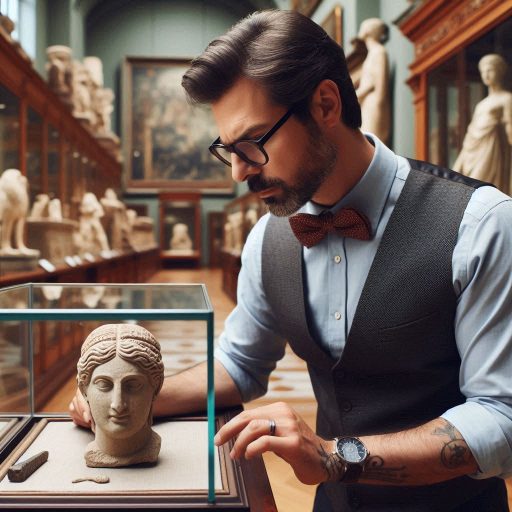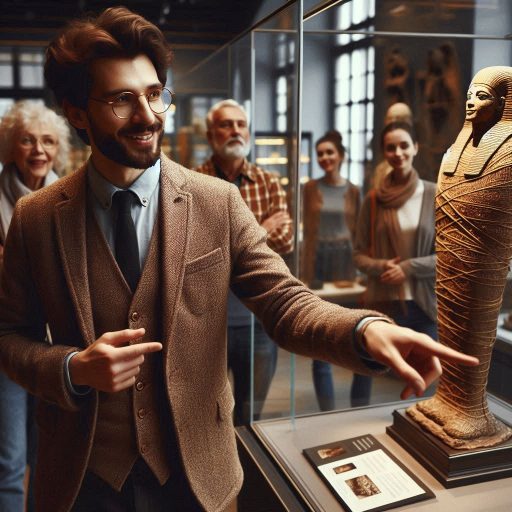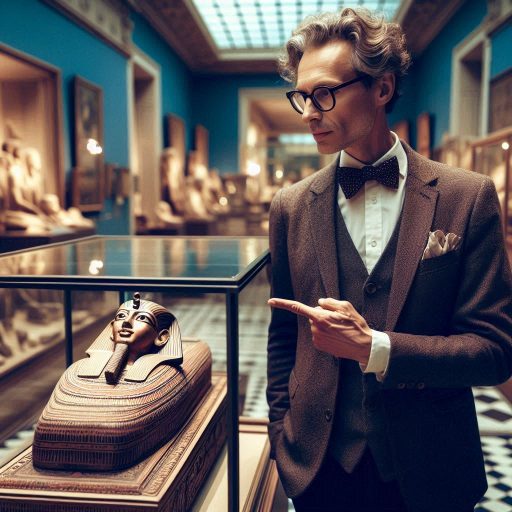Introduction
Transitioning from artist to museum curator opens exciting career paths.
Many artists seek new challenges beyond their creative practice.
This shift allows them to engage with art on a deeper level.
As curators, they influence how audiences experience art and culture.
The museum landscape is evolving.
Institutions increasingly value professionals with diverse backgrounds and experiences.
Artists bring unique perspectives that enhance curatorial practices.
Their deep understanding of creativity helps shape compelling exhibitions.
Interest in this transition is growing.
Many museums are recognizing the importance of inclusivity and innovation.
They actively seek individuals who can bridge the gap between creation and curation.
This trend reflects a broader demand for interdisciplinary approaches within the arts.
Artists possess skills that translate well into curation.
They understand artistic intent, audience engagement, and visual storytelling.
As curators, they can use these abilities to create meaningful narratives.
The result is a richer cultural experience for museum visitors.
This evolving field offers exciting opportunities.
Artists can carve out impactful careers as museum curators.
Embracing this change leads to personal growth and new avenues for artistic expression.
Research the Role of a Museum Curator
Transitioning from an artist to a museum curator requires understanding the curator’s role in depth.
Curators play a vital part in the art world.
They manage collections, organize exhibitions, and conduct research.
Each responsibility demands a unique set of skills and qualifications.
Here’s a closer look at what the role entails.
Responsibilities of a Curator
Curators manage collections of artworks and artifacts.
They oversee the acquisition, care, and preservation of these items.
This responsibility includes ensuring each piece is properly documented and stored.
They develop strategies for collection growth and improvement.
Organizing exhibitions is another key duty of a curator.
Curators plan and execute exhibitions that engage the public.
They select the artworks to display and create a cohesive narrative.
Additionally, they coordinate logistics, such as installation and lighting.
They work closely with artists and other professionals during this process.
Conducting research is essential for curators.
They must understand the historical and cultural context of the artworks.
This research informs exhibition themes and enhances the public’s experience.
Curators often write exhibition catalogs and educational materials.
They also give lectures and lead tours to share their knowledge.
Curators build relationships with artists, collectors, and other institutions.
Networking helps them gain access to new works and exhibitions.
Collaboration with fellow professionals enriches their understanding of contemporary practices.
This aspect of the job is crucial for maintaining a vibrant museum culture.
Skills and Qualifications
Curators require a blend of academic knowledge and practical skills.
A bachelor’s degree in art history or a related field is essential.
Many curators hold advanced degrees, such as a master’s or Ph.D.
This education equips them with in-depth knowledge of art and cultural theory.
Strong research skills are crucial for curators.
They must analyze artworks and contextualize them within their histories.
Excellent writing skills are also necessary.
Curators create informative texts that accompany exhibitions and publications.
Clear communication helps convey complex ideas to diverse audiences.
Curators need organizational skills to manage multiple projects.
They balance various responsibilities while adhering to strict deadlines.
Time management and prioritization become vital in this fast-paced environment.
Attention to detail is another critical skill for curators.
They must ensure the accuracy of exhibition labels and catalogs.
This precision reflects professionalism and respect for the artworks.
Curators should possess strong interpersonal skills.
They work with a variety of stakeholders, from artists to museum staff.
Building rapport and fostering collaboration are essential for success.
Technical skills also play a role in a curator’s job.
Familiarity with museum software and databases is often required.
Understanding how to use digital tools for exhibitions is increasingly important.
Transitioning from artist to museum curator involves extensive research into the role.
Understanding the responsibilities, skills, and qualifications necessary for the position is crucial.
By building a foundation in these areas, aspiring curators can successfully navigate this career shift.
Embracing the curator’s role opens up new opportunities to engage with art and the public.
Read: Character Design Trends: What’s Hot in 2024?
Assess Your Skills and Experiences
Transitioning from an artist to a museum curator requires thoughtful self-assessment.
Understanding your current skills and experiences is essential.
Reflect on your artistic journey and pinpoint the capabilities that align with curatorial roles.
Reflect on your experience as an artist and identify transferable skills
Begin by listing your artistic skills.
Think about your ability to create, critique, and communicate effectively.
Curators often possess similar abilities, including research, organization, and presentation.
Your experience in creating artworks helps you understand art from a unique perspective.
This insight can enhance exhibition planning.
Consider your experience in collaborative projects.
As an artist, you may have collaborated with galleries, fellow artists, or art organizations.
These interactions develop your networking and teamwork skills.
Curators frequently work with various stakeholders, so these experiences are valuable.
Identify how these skills can transfer to a curatorial role.
Evaluate your knowledge of art history and trends.
As an artist, you likely have studied various movements and styles.
This understanding is crucial for curators.
Curators curate collections and exhibitions based on historical context and current trends.
Highlight your familiarity with art movements when assessing your qualifications.
Assess your organizational abilities.
Artists often manage multiple projects simultaneously.
This skill translates well into curatorial tasks, such as organizing exhibitions and events.
Curators must coordinate logistics, budgets, and timelines effectively.
Your experience juggling different artistic commitments will serve you well.
Consider Additional Training or Education Needed to Fulfill the Requirements of a Curator Position
Once you’ve identified your transferable skills, consider if you need further training.
Research the specific requirements for curator positions in your desired field.
Many curators hold degrees in art history, museum studies, or related fields.
If you lack formal education in these areas, seek opportunities for further learning.
Explore local universities or online courses that offer museum studies programs.
These programs can provide foundational knowledge about museum practices and curation.
You may also find workshops focused on specific skills like exhibition design or collection management.
Taking these courses will strengthen your qualifications.
Consider internships or volunteer opportunities in museums or galleries.
Gaining practical experience is invaluable.
Working alongside experienced curators will expose you to the inner workings of the field.
Internships can also provide networking opportunities and enhance your resume.
Join professional organizations related to museum studies or curatorial practices.
Membership can grant you access to resources, conferences, and workshops.
Engaging with these communities will broaden your knowledge and connect you with industry professionals.
Networking is crucial for career advancement.
Reflect on your artistic identity and how it can contribute to your curatorial vision.
Curators often bring their unique perspectives to exhibitions.
Your background as an artist can set you apart from other candidates.
By assessing your skills and seeking additional training, you can confidently transition from artist to curator.
Embrace your journey, and remember that your artistic experiences are assets in this new role.
Read: How to Price Your Ceramic Artwork
Network Within the Museum Industry
Transitioning from artist to museum curator requires building a solid network within the museum industry.
Networking opens doors and creates opportunities that can help you in your career.
Here are key strategies for effective networking that can facilitate your transition.
Attend Industry Events and Conferences
Participating in industry events and conferences is essential.
These gatherings allow you to meet professionals in the museum field.
Engage in discussions and exchange ideas with curators, artists, and museum staff.
Attend workshops, panels, and lectures to broaden your knowledge and skills.
When you attend these events, be proactive.
Introduce yourself to speakers and fellow attendees.
Prepare a brief introduction about your background and aspirations.
Have business cards ready to share your contact information.
Follow up with new connections after the event.
A simple email expressing your appreciation can leave a lasting impression.
Keep an eye on the calendar of events in your area.
Many museums and cultural institutions host public programs.
Participate in local art fairs, gallery openings, and museum exhibitions.
These events provide a relaxed environment to network.
You can also gain insight into current trends and practices in curation.
Consider joining professional organizations related to museums and curation.
Many of these organizations offer resources, networking opportunities, and workshops.
Membership often includes access to exclusive events and conferences.
This involvement can enhance your credibility in the field.
Participating in organization activities can deepen your connections.
Volunteer for committees or events to demonstrate your commitment.
This proactive approach helps you build relationships with established professionals.
It also positions you as an engaged member of the community.
Seek Mentorship Opportunities
Finding a mentor is invaluable during your transition.
Experienced curators can offer insight and guidance tailored to your goals.
They can provide advice on navigating the complexities of the museum world.
A mentor can also help you identify potential career paths.
Start by reaching out to curators whose work you admire.
Craft a thoughtful email expressing your interest in their career journey.
Ask if they would be open to a mentorship relationship.
Be respectful of their time and offer to meet at their convenience.
Utilize professional organizations to find mentors as well.
Many have mentorship programs designed to connect emerging professionals with experienced curators.
This structured approach can provide a strong foundation for your transition.
In addition to seeking mentors, build relationships with museum staff.
Connect with educators, registrars, and conservators to broaden your perspective.
Each role within the museum contributes to the overall mission.
Understanding their functions will enhance your curatorial skills.
Collaborate on projects or volunteer opportunities to gain hands-on experience.
Demonstrating your skills and passion can impress museum professionals.
This approach not only builds your resume but also strengthens your network.
Networking within the museum industry is crucial for your transition.
By attending events, joining organizations, seeking mentorship, and building relationships, you will lay a strong foundation for your career as a curator.
Embrace the opportunities that come your way and watch your professional network grow.
Read: Top Skills Needed for a Successful Character Designer

Gain Practical Experience
Transitioning from an artist to a museum curator requires practical experience.
Volunteering or interning at a museum is a great starting point.
This hands-on involvement allows you to understand museum operations.
You will witness firsthand how exhibitions are planned and executed.
Volunteer or Intern at Museums
Many museums offer internships for aspiring curators.
These positions can provide invaluable insights into curation processes.
You will learn about collection management and exhibition design.
Internships also allow you to observe how curatorial teams collaborate.
Consider applying for volunteer opportunities at local museums.
Volunteering can give you access to various aspects of museum work.
You might assist with organizing exhibitions or managing collections.
This experience will enhance your resume and expand your network.
Building connections with museum professionals can open doors in your career.
Freelancing in Curation
Freelancing offers valuable experience for aspiring curators.
Many artists freelance to build their portfolios and showcase their expertise.
These projects allow you to experiment with exhibition styles and design compelling narratives through art.
Start by contacting galleries and cultural institutions.
Small galleries often seek freelance curators for exhibitions.
Propose unique exhibition concepts that reflect your artistic vision to enhance your portfolio and reputation.
Document your work meticulously.
Maintain a portfolio with images and descriptions of exhibitions you’ve organized.
Highlight your roles and responsibilities to demonstrate your skills and accomplishments.
Joining professional organizations like the American Alliance of Museums can also expand your experience.
Membership provides access to workshops, conferences, and networking opportunities with industry professionals.
These resources help refine your curatorial skills.
Online courses focused on curation offer essential knowledge about exhibition planning, art conservation, and audience engagement.
These courses are excellent tools for learning museum practices.
Engage with local artists and communities by attending artist talks, workshops, and community events.
Understanding diverse perspectives will deepen your curatorial practice.
Gaining practical experience through freelancing, volunteering, or interning is key to transitioning into curatorial roles.
Document your experiences and build a strong portfolio to enhance your credibility.
Stay connected to the art community and continuously invest in professional development.
With dedication and hands-on experience, you can successfully transition from artist to museum curator.
Read: Career Paths in Ceramic Art and Design
Transform Your Career Today
Unlock a personalized career strategy that drives real results. Get tailored advice and a roadmap designed just for you.
Start NowPursue Further Education or Certifications
Transitioning from an artist to a museum curator requires a strong foundation of knowledge and skills.
One effective way to build this foundation is through further education or certifications.
These credentials enhance your qualifications and deepen your understanding of museum practices.
Enroll in a Museum Studies Program
Consider enrolling in a museum studies program.
These programs provide an in-depth look at museum operations.
They cover topics such as collections management, exhibition design, and art history.
Most programs combine theoretical knowledge with practical experiences.
This combination prepares you for the challenges of curatorial work.
Research different universities and institutions that offer museum studies programs.
Some programs offer online courses, making them accessible regardless of your location.
Choose a program that aligns with your interests and career goals.
Look for opportunities that allow you to specialize in a specific area, such as contemporary art or historical artifacts.
Participating in internships during your studies is crucial.
Internships provide hands-on experience in real-world settings.
They allow you to connect with professionals in the field.
Use these opportunities to gain insight into daily museum operations and curatorial tasks.
Obtain Relevant Certifications
To advance your career as a museum curator, seek certifications in collections management, exhibition design, or art history.
These specialized credentials demonstrate your commitment to professional growth and enhance your resume.
Many organizations offer certification programs tailored to museum professionals.
Research programs that offer practical training and relevant coursework.
Certifications also expand your professional network.
Stay current with industry trends by attending workshops, conferences, and seminars on museum practices.
These events connect you with experts who share the latest developments in the field.
Engage with these professionals to inspire new ideas for your curatorial work.
Joining professional organizations in museum studies is also beneficial.
These groups offer resources, networking opportunities, and best practice guides.
Engaging with peers helps you stay informed about changes in the museum landscape.
Networking is crucial.
Reach out to curators, educators, and museum staff to gain valuable insights and advice.
Attend gallery openings, museum exhibitions, and art fairs to meet individuals in the art and museum fields.
Introduce yourself, express your interest in curatorial work, and follow up with contacts.
Pursuing further education and certifications strengthens your transition from artist to curator.
Museum studies programs enhance your skills and knowledge, preparing you for curatorial challenges.
Embrace continuous learning and networking to build a successful career in the museum industry.
Develop a Strong Portfolio
Create a comprehensive portfolio
A strong portfolio is essential when transitioning from artist to museum curator.
This collection showcases your artwork, curatorial projects, and relevant experience.
It serves as your visual resume, displaying your unique perspective and approach to curation.
Here are steps to create an effective portfolio.
Showcase Your Artwork
Begin by selecting a diverse range of your artwork.
Choose pieces that reflect your style and artistic journey.
Include works from various periods of your career.
This diversity demonstrates your growth and versatility as an artist.
Remember, each piece should tell a story.
Provide context for your work to engage the viewer.
Use captions or descriptions to convey your intentions and inspirations.
Include Curatorial Projects
Incorporate any curatorial projects you have undertaken.
Highlight exhibitions where you played a significant role.
Describe your contributions to each project, such as theme development and artist selection.
Discuss how you organized and promoted the exhibition.
This showcases your practical experience and understanding of the curatorial process.
Emphasize Relevant Experience
List any relevant experiences that contribute to your qualifications as a curator.
This could include internships, volunteer work, or collaborations with galleries.
Provide details about your responsibilities in these roles.
Highlight specific skills you developed, such as research, organization, and communication.
Highlight Your Unique Perspective and Approach to Curation, and Demonstrate your Passion for the field
Your portfolio should reflect your unique perspective on curation.
Include a personal statement that outlines your vision and approach.
Discuss what inspires you as a curator and how your artistic background informs your curatorial work.
This statement sets you apart from others in the field.
The presentation of your portfolio is just as important as its content.
Organize your pieces in a logical and visually appealing manner.
Use high-quality images to represent your artwork and projects.
Ensure your portfolio flows seamlessly from one section to the next.
Consider the overall aesthetic of your portfolio, as it reflects your taste and professionalism.
Your passion for the field should resonate throughout your portfolio.
Use it as an opportunity to express your enthusiasm for art and curation.
Share any personal stories or experiences that shaped your artistic journey.
Highlight how these experiences have influenced your desire to become a curator.
This personal touch can help you connect with potential employers.
Developing a strong portfolio is a vital step in your transition from artist to curator.
It showcases your talent, experience, and passion for the field.
By carefully selecting and presenting your work, you can create a powerful tool that opens doors to new opportunities.
Remember, your portfolio is not just a collection; it is a reflection of your artistic identity and curatorial vision.
Apply for Curator Positions
Transitioning from an artist to a museum curator involves actively seeking relevant job opportunities.
Start by researching job openings at museums and galleries that align with your interests and skills.
This crucial step helps you identify the right positions to pursue.
You should focus on institutions that showcase art forms you are passionate about.
Research Job Openings
Begin your search by exploring various museum and gallery websites.
These sites often list current job openings in their careers section.
Use keywords like “curator,” “exhibition coordinator,” or “collection manager” when searching.
Consider checking local, national, and international institutions.
The broader your search, the more opportunities you may find.
Networking can also help you discover job openings.
Attend gallery openings, art fairs, and curator talks.
Connect with professionals in the museum sector through social media platforms like LinkedIn.
Engaging with curators and museum staff can provide valuable insights into potential job openings.
They might even refer you to positions before they are publicly advertised.
Tailor Your Resume and Cover Letter
Once you identify potential curator positions, it’s time to focus on your application materials.
Tailor your resume to highlight relevant experiences from your artistic background.
Emphasize skills that are transferable to a curatorial role.
For example, if you have organized exhibitions, showcase that experience prominently.
In your cover letter, clearly express your passion for the role.
Discuss how your experience as an artist enhances your qualifications as a curator.
Provide specific examples of your artistic work that demonstrate your understanding of art history and curation.
This personalized approach will make your application stand out.
While crafting your resume, consider including specific skills that align with curatorial tasks.
Highlight skills such as project management, communication, and collaboration.
Curators often work with various stakeholders, so showcasing your teamwork abilities is essential.
Include any experience you have in research or educational programming.
If you have experience with collection management systems or digital cataloging, mention that too.
Familiarity with these tools can be a significant asset.
Curators often rely on technology to manage collections and track inventory.
Once you secure an interview, prepare thoroughly.
Research the museum or gallery, its mission, and its current exhibitions.
Familiarize yourself with their collection and recent curatorial initiatives.
Prepare to discuss how your background as an artist informs your curatorial vision.
Practice answering common interview questions for curatorial positions.
Be ready to explain your approach to exhibition design and audience engagement.
This preparation demonstrates your enthusiasm for the role and your commitment to the institution’s mission.
Applying for curator positions requires dedication and a strategic approach.
By researching job openings and tailoring your application materials, you can effectively showcase your qualifications.
Embrace this journey with confidence, and you’ll be one step closer to a fulfilling career as a museum curator.
Conclusion
Transitioning from artist to museum curator requires careful planning and dedication.
Start by gaining relevant academic qualifications in art history and museum studies.
Develop your expertise by volunteering or interning at museums to gain practical experience in curation.
Network with professionals in the field and stay updated on current trends.
Build a strong portfolio showcasing your curation projects and artistic background.
Tailor your resume and cover letter to highlight your relevant skills and experiences.
When applying for curator positions, be prepared to demonstrate your knowledge of art history, exhibition design, and museum management.
Emphasize your passion for preserving and showcasing art.
Continue to expand your knowledge and skills through professional development opportunities and ongoing education.
Stay committed to your goal of becoming a museum curator and take proactive steps to make it a reality.
Remember, the journey from artist to museum curator may not be easy, but with determination and perseverance, you can achieve your dreams in the field of curation.
So, go ahead and pursue your goals with confidence and enthusiasm.
[E-Books for Sale]
The Big Book of 500 High-Paying Jobs in America: Unlock Your Earning Potential
$19.99 • 500 High-Paying Jobs • 330 pages
Explore 500 high-paying jobs in America and learn how to boost your career, earn more, and achieve success!
See All 500 High-Paying Jobs of this E-Book
1001 Professions Without a Degree: High-Paying American Jobs You Can Start Now
$19.99 • 1001 Professions Without a Degree • 174 pages
Discover 1001 high-paying jobs without a degree! Unlock career tips, skills, and success strategies for just $19.99!




